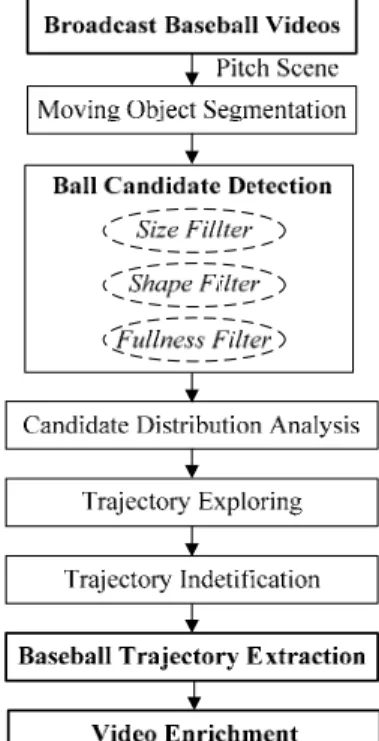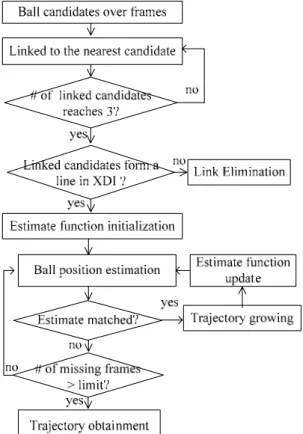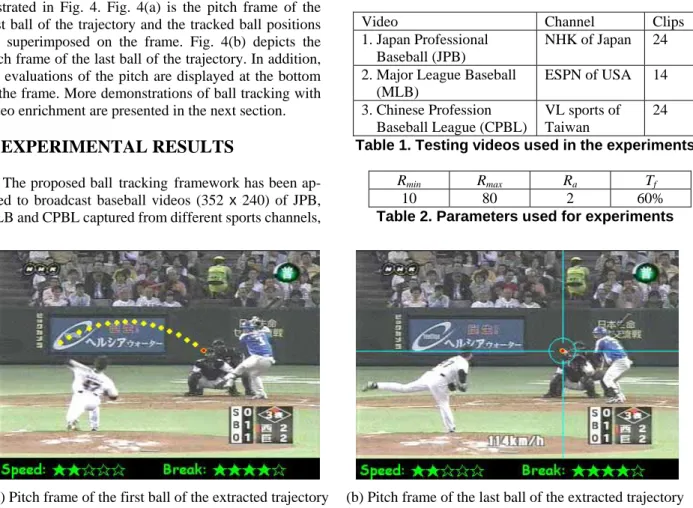A Trajectory-Based Ball Tracking Framework with Enrichment for Broadcast Baseball Videos
全文
(2) of the pitched ball which evaluates a breaking ball by the curvature of the obtained trajectory and measures the speed of a fastball by the number of the detected ball candidates for video enrichment.. Fig. 1. Block diagram of the proposed ball tacking and video enrichment. 3: BALL TRACKING AND TRAJECTORY EXTRACTION Now we describe in turn the components of the algorithm: moving object segmentation, ball candidate detection, candidate distribution analysis, trajectory exploring and trajectory identification. The process of pitch scene detection is omitted, since it has been researched well in the literature.. 3.1: MOVING OBJECT SEGMENTATION Since the baseball in the video is white and bright, the luminance of the ball in a frame should be higher. That is, the moving ball is likely to be in the positive regions of intensity difference between frames. Hence, the positive regions of intensity difference between the current frame and the second frame before are segmented as moving objects, where the interval of two frames is used for the reason that it reveals a more complete shape of the ball than one-frame interval by experiments. Morphological operations are then performed to remove noises and make the regions filled.. 3.2: BALL CANDIDATE DETECTION In a frame, many non-ball objects might look like the ball and it is difficult to recognize which is the true one.. Therefore, all detected moving objects are taken into consideration and sifted through the following filters with constraints. The remaining objects are considered as the ball candidates of the frame. Size Filter: The moving objects are filtered out if their sizes are not within the range [Rmin , Rmax], which is decided by statistical results. Shape Filter: The ball in the frame might have a shape different from a circle, but in most frames, its aspect ratio should be within the range [1/Ra , Ra]. The objects with aspect ratios out of the range should be filterer out. Fullness Filter: Some objects in different shapes (star-shaped, cross-shaped, triangular, etc.) may pass through the ball size filter and shape filter because of proper size and aspect ratio. For this reason, the fullness filter is built to remove the objects with the degrees of fullness Df less than a threshold of Tf . Df is defined as: Df = Sobj / Ab-box , (1) where Sobj is the size of the object in pixels and Ab-box is the bounding box area of the object. After filtering, the remaining objects are classified into isolated and contacted candidates according to their nearest objects in the frame. A candidate is called isolated if there is no neighboring object at a shorter distance than the average ball size, (Rmin+Rmax)/2, and it is called contacted otherwise. This classification is important because the candidate close to other moving objects might be an over-segmented region of the pitcher or batter.. 3.3: CANDIDATE DISTRIBUTION ANALYSIS In a pitch scene, the baseball trajectory show in a almost parabolic curve due to the gravity, even for a fastball. By advanced analysis, in frames the ball moves parabolically in Y-direction and straightly in X-direction as time goes on. Exploiting this characteristic, a 2-D distribution analysis which preserves more information than the 1-D analysis [6] is proposed that ball candidate distribution in both Y- and X- directions analyzed to explore the trajectory more reliably. A candidate distribution image is created by drawing the distribution of the candidates for a sequence of frames. The Y-distribution image (YDI) is created in such a way that its width equals the frame number of the given sequence and its height equals the height of the frame. Each isolated (or contacted) candidate draws a black dot (or green cross) in YDI at point (x , y) = (n , yc), where n is the frame serial number and yc is the y-coordinate of the candidate in the original frame (the left-bottom corner of the frame is taken as the origin for presentation clarity of the parabolic curves). Similarly, the X-distribution image (XDI) is also created that its height equals the width of the frame, and each isolated (or contacted) candidate draws a black dot (or green cross) in XDI at point (x , y) = (n , xc), where xc is the x-coordinate of the candidate in the frame. Fig. 2(a) presents an example of YDI and XDI.. - 1146 -.
(3) Y-distribution image (YDI). X-distribution image (XDI). (a) Ball candidates. Black dots are isolated candidates and green crosses are contacted ones.. (b) Candidate trajectories. The parabolic curves in YDI and straight lines in XDI represent candidate trajectories, among which the identified trajectories are colored red. Fig. 2. Illustration of the Y- and X-distribution images for different process stages. In the figure, n is the frame serial number, y in YDI and x in XDI are the y- and x-coordinates of each candidate in the original frame, respectively, tion, the estimate functions for YDI and XDI are initialized as Eq.(2) and Eq.(3), when the number of linked candidates is up to three (three points form a parabola). y = a • n2 + b • n + c , a < 0 (2) x=d•n+e (3) With the estimate functions, the ball position in the next frame is estimated. The estimate is considered matched if a ball candidate close to the estimated position is found. The trajectory then grows by adding this candidate and the estimate functions are updated. If there is no candidate close to the estimated position, the frame is regarded as a missing frame and the estimated position is taken as the ball position. The trajectory growing terminates when the number of consecutive missing frames reaches a given limit (4 in our experiments). The candidate trajectories produced from this procedure are shown as the parabolic curves in YDI and straight lines in XDI, as depicted in Fig. 2(b).. 3.5: TRAJECTORY IDENTIFICATION. Fig. 3. Procedure of ball trajectory exploring. 3.4: TRAJECTORY EXPLORING The procedure to explore trajectories in YDI and XDI is summarized in Fig. 3. All ball candidates are first linked to the nearest neighbor in the next frame. As mentioned above, since in frames the ball moves parabolically in Y-direction and straightly in X-direc-. To indicate how likely a candidate trajectory is a ball trajectory, some confidential degrees are given by evaluating the following properties: estimation error, trajectory length and the ratio of isolated candidates. Estimation error: The average distance of each ball candidate position from the estimated position is considered as estimation error. A confidential degree C1 for estimation error is given to each candidate trajectory that slighter estimation error results in a higher degree. The candidate trajectories with considerable estimation error are eliminated. Trajectory length: The confidential degree C2 for trajectory length given to each candidate trajectory is. - 1147 -.
(4) proportional to its length because shorter trajectories are more likely noises. Ratio of isolated candidate: Since the pitched ball is far from other moving objects in most frames, the ball trajectory should contain more isolated candidates than contacted ones. Hence, a confidential degree C3 is given proportionally to the ratio of isolated candidates. The candidate trajectory with the highest sum of C1, C2 and C3, is identified as the ball trajectory. In Fig. 2(b), among the candidate trajectories, the identified trajectories are colored red. With the identified trajectory in YDI and XDI, the ball trajectory is computed and superimposed on the frame.. 4: VIDEO ENRICHMENT Based on the tracked ball positions and extracted trajectory, some visual presentations are provided for video enrichment. Fist, the speed of the pitched ball can be estimated from the time interval between the start and the end of the extracted trajectory. Second, the curvature of the parabolic curve in YDI can be used to evaluate a breaking ball. Moreover, the frame containing the first ball of the extracted trajectory displays the posture of the pitcher, while the frame containing the last ball of the trajectory indicates the ball position when it passes through the homeplate and the batter. An example of video enrichment for a pitch is demonstrated in Fig. 4. Fig. 4(a) is the pitch frame of the first ball of the trajectory and the tracked ball positions are superimposed on the frame. Fig. 4(b) depicts the pitch frame of the last ball of the trajectory. In addition, the evaluations of the pitch are displayed at the bottom of the frame. More demonstrations of ball tracking with video enrichment are presented in the next section.. 5: EXPERIMENTAL RESULTS. as listed in Table 1. Note that only pitch scenes are processed. Table 2 lists the parameter setting used in the experiments. The ball position of each video frame is manually recognized as ground truth. The experimental results of ball detection and tracking are listed in Table 3, where in the first column, “Video (Channel)” represents the video source and channel, “Pitch scenes” shows the clip number of each source, “Frames” represents the number of total frames in all clips, “Balls” represents the number of the frames containing the ball, “detected (%)” gives the number (percentage) of detected balls, “Miss” gives the number of missed ball, “False Alarm” gives the number of false-detected ball positions, and “tracked (%)” gives the number (percentage) of tracked balls. A ground truth ball is called “detected” if it matches a ball candidate generated in Ball Candidate Detection module (Section 3.2). It can be found that the percentages of the ball detection are not very high because the ball might be missed when it is passes through a left-handed batter. A ground truth ball falling on the obtained trajectory is called “tracked”, since the ball position can be estimated on the trajectory by the motion characteristics even though it does not match a ball candidate. Although there are some tracking errors, the proposed method promotes the accuracy for ball tracking up to 96%. Fig. 5 demonstrates some ball tracking examples with video enrichment for different broadcast baseball videos containing left- and right- handed pitcher and batter. Video Channel Clips 1. Japan Professional NHK of Japan 24 Baseball (JPB) 2. Major League Baseball ESPN of USA 14 (MLB) 3. Chinese Profession VL sports of 24 Baseball League (CPBL) Taiwan Table 1. Testing videos used in the experiments. The proposed ball tracking framework has been applied to broadcast baseball videos (352 x 240) of JPB, MLB and CPBL captured from different sports channels,. Rmax Ra Tf Rmin 10 80 2 60% Table 2. Parameters used for experiments. (a) Pitch frame of the first ball of the extracted trajectory (b) Pitch frame of the last ball of the extracted trajectory with tracked ball positions superimposed on the frame with the focus aiming at the ball Fig. 4. Demonstration of the obtained ball trajectory superimposed on the frame. - 1148 -.
(5) (a) JPB with left-handed pitcher and right-handed batter. (b) MLB with right-handed pitcher and right-handed batter. (c) CPBL with right-handed pitcher and right-handed batter. (d) JPB with right-handed pitcher and left-handed batter Fig. 4. Examples of ball tracking and video enrichment for different baseball videos. - 1149 -.
(6) Video (Channel) Pitch scenes Frames Balls Detected (%) Miss False Alarm Tracked (%). 1. JPB (NHK) 2. MLB (ESPN) 3.CPBL (VL) 24 14 24 1726 604 942 346 202 352 324 (93.64 %) 190 (94.06%) 326 (92.61%) 22 12 26 8 5 7 336 (97.11%) 196 (97.03%) 338 (96.02%) Table 3. Performance of ball detection and tracking. 6: CONCLUSIONS In this paper, we present a trajectory-based ball tracking scheme which is capable of extracting the ball trajectory in broadcast baseball videos. Non-ball objects are first filtered out by the constraints of size, shape and fullness. The motion of the baseball has a characteristic that the pitched ball moves in a parabolic curve. Utilizing this characteristic, the ball trajectory can be identified reliably. Based on the properties of the extracted trajectory, the baseball video is enriched by some visual presentations and the evaluation of the pitch is also provided. The novelty of the proposed baseball video analysis is that our approach is based on the motion characteristics rather than traditional tracking methods based on low-level features. Furthermore, the speed of a fastball is measured by the time interval of the trajectory, and a breaking ball is also evaluated by the curvature of the extracted trajectory. The presentation of the ball trajectory superimposed on the video not only shows the flight of the ball for entertainment effects but also provides reference for player training. Our experiments on 62 clips from different channels show convincible performance. In the future, the trajectory extracted in the framework of this paper will be further analyzed to recognize pitch types such as fastball, curveball, slider and other breaking ball in baseball videos. A practical system will be produced for further pitch analysis and intelligence collection in baseball videos.. REFERENCES [1] Hua, W., Han, M., Gong, Y.: Baseball Scene Classification using Multimedia Features. Multimedia and Expo, 2002.ICME'02.Proceedings.2002 IEEE International Conference on, 1 (2002) 821-824. [2] Pei, S. C., Chen, F.: Semantic Scenes Detection and Classification in Sports Videos. Proceedings of IPPR Conference on Computer Vision, Graphics and Image Processing (CVGIP), (2003) 210–217. [3] Rui, Y., Gupta, A., Acero, A.: Automatically Extracting Highlights for TV Baseball Programs. Proceedings of the eighth ACM international conference on Multimedia, (2000) 105-115.. Overall 62 3272 900 840 (93.33%) 60 20 870 (96.67%). [4] Xiong, Z., Radhakrishnan, R., Divakaran, A., Huang, T.: Highlights Extraction from Sports Video Based on an Audio-Visual Marker Detection Framework. Multimedia and Expo, 2005.ICME 2005.IEEE International Conference on, (2005) 29-32. [5] Xie, L., Chang, S. F., Divakaran, A., Sun, H.: Structure Analysis of Soccer Video with Hidden Markov Models. Acoustics, Speech, and Signal Processing, 2002.Proceedings. (ICASSP'02). IEEE International Conference on, 4 (2002). [6] Yu, X., Xu, C., Leong, H. W., Tian, Q., Tang, Q., Wan, K. W.: Trajectory-Based Ball Detection and Tracking with Applications to Semantic Analysis of Broadcast Soccer Video. Proceedings of the eleventh ACM international conference on Multimedia, (2003) 11-20. [7] Wang, J. R., & Parameswaran, N.: Detecting Tactics Patterns for Archiving Tennis Video Clips. Multimedia Software Engineering, 2004.Proceedings.IEEE Sixth International Symposium on, (2004) 186-192. [8] Shum, H., & Komura, T.: A Spatiotemporal Approach to Extract the 3D Trajectory of the Baseball from a Single View Video Sequence. Multimedia and Expo, 2004.ICME'04.2004 IEEE International Conference on, 3 (2004) 1583-1586. [9] Kim, T., Seo, Y., Hong, K. S., POSTECH, P.: Physics-Based 3D Position Analysis of a Soccer Ball from Monocular Image Sequences. Computer Vision, 1998.Sixth International Conference on, (1998) 721-726. [10] Pingali, G., Opalach, A., Jean, Y.: Ball Tracking and Virtual Replays for Innovative Tennis Broadcasts. Proceedings of the 15th International Conference on Pattern Recognition, 4 (2000) 152-156. [11] Hawk-Eye, http://news.bbc.co.uk/sport1/hi/tennis/2977068.stm. [12] Gueziec, A.: Tracking Pitches for Broadcast Television. Computer, 35 (2002) 38-43. [13] QUESTEC, http://www.questec.com/q2001/prod_uis.htm. [14] Farin, D., Han, J.: Fast Camera Calibration for the Analysis of Sport Sequences. Multimedia and Expo, 2005.ICME 2005.IEEE International Conference on, (2005) 482-485. [15] Farin, D., Krabbe, S., Peter H. N., Effelsberg, W.: Robust Camera Calibration for Sport Videos using Court Models. Proceedings of SPIE, 5307 (2004) 80.. - 1150 -.
(7)
數據



相關文件
In the algorithm, the cell averages in the resulting slightly non-uniform grid is updated by employing a finite volume method based on a wave- propagation formulation, which is very
One of the main results is the bound on the vanishing order of a nontrivial solution u satisfying the Stokes system, which is a quantitative version of the strong unique
Reading Task 6: Genre Structure and Language Features. • Now let’s look at how language features (e.g. sentence patterns) are connected to the structure
In the first paragraph, how does the writer convince us that many people think the classroom of the future will be based on technology.. (A) She describes
Establish a check and balance mechanism to ensure that fee remission is offered in accordance with the school-based eligibility criteria, which should be no less favourable than
Because simultaneous localization, mapping and moving object tracking is a more general process based on the integration of SLAM and moving object tracking, it inherits the
* All rights reserved, Tei-Wei Kuo, National Taiwan University, 2005..
The remaining positions contain //the rest of the original array elements //the rest of the original array elements.